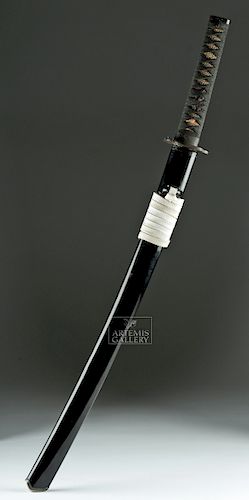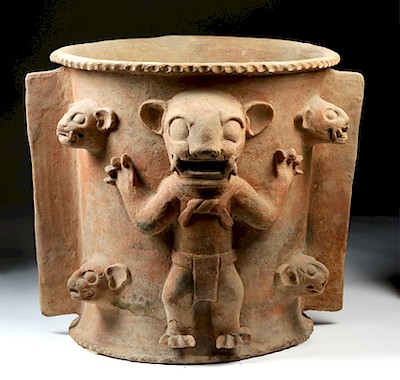Signed 17th C. Japanese Tadayoshi Wakizashi & Scabbard
Lot 122b
About Seller
Artemis Fine Arts
686 S Taylor Ave, Ste 106
Louisville, CO 80027
United States
Selling antiquities, ancient and ethnographic art online since 1993, Artemis Gallery specializes in Classical Antiquities (Egyptian, Greek, Roman, Near Eastern), Asian, Pre-Columbian, African / Tribal / Oceanographic art. Our extensive inventory includes pottery, stone, metal, wood, glass and textil...Read more
Categories
Estimate:
$3,500 - $5,000
Absentee vs Live bid
Two ways to bid:
- Leave a max absentee bid and the platform will bid on your behalf up to your maximum bid during the live auction.
- Bid live during the auction and your bids will be submitted real-time to the auctioneer.
Bid Increments
| Price | Bid Increment |
|---|---|
| $0 | $25 |
| $300 | $50 |
| $1,000 | $100 |
| $2,000 | $250 |
| $5,000 | $500 |
| $10,000 | $1,000 |
| $20,000 | $2,500 |
| $50,000 | $5,000 |
| $100,000 | $10,000 |
| $200,000 | $20,000 |
About Auction
By Artemis Fine Arts
Dec 6, 2018
Set Reminder
2018-12-06 10:00:00
2018-12-06 10:00:00
America/New_York
Bidsquare
Bidsquare : DAY 2 : Pre-Columbian, Ethnographic & Fine Art
https://www.bidsquare.com/auctions/artemis-gallery/day-2-pre-columbian-ethnographic-fine-art-3699
Day 2 of an important 2-dy auction featuring ancient and ethnographic art from around the world. Today's sale will feature Pre-Columbian, Native American, African / Tribal, Ethnographic, Spanish Colonial, Fine Art, much more. Artemis Fine Arts info@artemisgallery.com
Day 2 of an important 2-dy auction featuring ancient and ethnographic art from around the world. Today's sale will feature Pre-Columbian, Native American, African / Tribal, Ethnographic, Spanish Colonial, Fine Art, much more. Artemis Fine Arts info@artemisgallery.com
- Lot Description
**First Time At Auction**
East Asia, Japan, early Edo Period, ca. 1615 to 1624 CE, signed by Hashimoto Shinzaemon Tadayoshi (1572-1632 CE). An incredible wakizashi with a single-edged blade, a scabbard (saya) made of lacquered (urushi) wood with a silver cap (kojiri), and a handle (tsuka) wrapped with stingray skin (same) and cotton straps (tsuka-ito) topped with a buffalo horn cap (kashira). Two copper-iron bird ornaments (menuki) are wrapped in the handle. The lobed iron hand guard (mokko tsuba) has hammered floral motifs, and a brass outer ring sits just above the copper blade cap (seppa). The shinogi-zukuri steel blade has a higher ridge line than the typical shobu-zukuri design, a diamond-shaped (iori-mune) profile, and a lightly-curved (chu-kissaki) tip. A gentle wave (notare-hamon) formed by the tight-grained hammer-folding process (itame-hada) runs the length of the blade. The tang is hammered with the signature "Hizen koku Tadayoshi." Size: 31" L x 2.875" W (78.7 cm x 7.3 cm); size (blade): 21.4" L (54.4 cm).
This traditional Japanese sword was both a weapon and a symbol of authority and social status. The wakizashi paired with the longer katana sword marked the wearer as a samurai. The shorter sword was seen as an auxiliary weapon, also used for fighting in close quarters. Wakizashi could also be worn by non-samurai if worn alone, and members of the merchant class (chonin) wore them because of the frequency of encountering bandits when traveling between Japan's cities.
Over the centuries that katana and wakizashi were made, the process of their manufacture became heavily regulated. For example, in 1683, the Tokugawa Shogunate made laws concerning the maximum size of katana and wakizashi. Meanwhile, once a samurai took ownership of his new weapon, he had to wear it in a highly-regulated manner. Wakizashi and katana in this period were both deadly weapons and signs of prestige. The craftsmanship of this piece is evident and reflects hundreds of hours of work.
The signature on this blade, "Hizen koku Tadayoshi," gives us the name of the swordsmith who created this marvelous weapon. The artisan, Hashimoto Shinzaemon (1572-1632 CE), was born in the Saga district of Hizen province; Hizen is the old name for the northwestern region of Kyushu and almost overlaps with the current Saga and Nagasaki prefectures. He began studying under master swordsmith Umetada Myoju in Kyoto in 1596, and moved back to the Saga district two years later upon completing his training. This first-generation Tadayoshi sword was created in the Hizen province because the process of hammer-folding the blade seen here (itame-hada) is a characteristic production technique of this region. We also know this blade was created before the year 1624 because Tadayoshi changed his smithing name to "Tadahiro" in October of that year and continued signing his blades with this name until his death in 1632 CE. (Sesko, Marcus. "Nihon-Shinto-Shi: The History of the Shinto-Era of Japanese Swords." Lulu, Inc., 2013, p. 355)
A stylistically-similar example consisting of just the blade portion hammered for $6,875 at Christie's, New York "Legacy & Heritage: The De Guigne Collection" auction (sale 12189, March 24, 2016, lot 163): https://www.christies.com/lotfinder/lot/a-japanese-wakizashi-sword-mid-17th-century-5973287-details.aspx?from=searchresults&intObjectID=5973287&sid=9edd4ac5-464a-44a9-9d23-279357e6ff26
Provenance: private Jones collection, Boulder, Colorado, USA
All items legal to buy/sell under U.S. Statute covering cultural patrimony Code 2600, CHAPTER 14, and are guaranteed to be as described or your money back.
A Certificate of Authenticity will accompany all winning bids.
We ship worldwide and handle all shipping in-house for your convenience.
#139691Blade is in excellent condition with only small areas of abrasions and dark spots. Light oxidation to hand guard, handle ring, and menuki, light wear to silver scabbard cap, some yellowing to stingray skin, and small chips to scabbard, otherwise intact and excellent. Light yellowing to exterior textile strap.Condition
- Shipping Info
-
All shipping is handled in-house for your convenience. Your invoice from Artemis Gallery will include shipping calculation instructions. If in doubt, please inquire BEFORE bidding for estimated shipping costs for individual items.
-
- Buyer's Premium



 EUR
EUR CAD
CAD AUD
AUD GBP
GBP MXN
MXN HKD
HKD CNY
CNY MYR
MYR SEK
SEK SGD
SGD CHF
CHF THB
THB

















